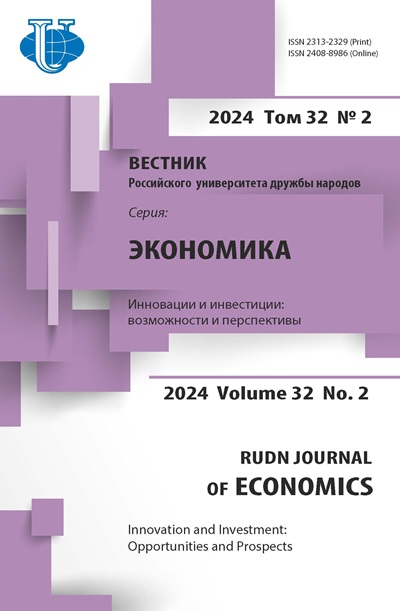The role of direct investment in the development of Russia’s innovative economy (1991-2017)
- Authors: Diesperova NA1
-
Affiliations:
- Peoples’ Friendship University of Russia
- Issue: Vol 26, No 3 (2018)
- Pages: 402-415
- Section: GLOBALIZATION AND ECONOMIC INTEGRATION
- URL: https://journals.rudn.ru/economics/article/view/20296
- DOI: https://doi.org/10.22363/2313-2329-2018-26-3-402-415
Cite item
Full Text
Abstract
The article examines the impact of direct investments, including FDI, on the development of Russia’s innovative economy. The unfavorable situation in the Russian national innovation system is shown: the basic indicators of innovation in 2017 remain at the level of 2000. The negative influence of FDI on the Russian industry, which is due to the passive position of the state in managing the investment flow, has been revealed. The article proposes an approach to the building of a management system of the institutes of the national innovation systems (NIS) based on the principle of ensuring mutually beneficial conditions for all participants of the innovation process. On the example of experience of activity of venture funds and technoparks, the need for state control of the effectiveness of innovative institutions, based on their contribution to the growth of the number of innovative active enterprises in the real sectors of the Russian economy as the main criterion for investment management is justified.
About the authors
N A Diesperova
Peoples’ Friendship University of Russia
Author for correspondence.
Email: diesperova_natal@mail.ru
Candidate of Sciences (Economics), Associate Professor of the Department of Applied Economics of the Institute of Space Technologies at Peoples’ Friendship University of Russia
6 Miklukho-Maklaya St., Moscow, 117198, Russian FederationReferences
- Obzor rynka pryamyx i venchurnyx investicij v Rossii: analiticheskie sborniki RAVI. 1994—2017.
- Retrieved from: https://www.allventure.ru (accessed: 15.03.2018). (In Russ.)
- Doklad Stoly’pinskogo kluba «Ekonomika rosta» (2015). Retrieved from: http://expert.ru/data/ public/499741/499785/dir-polnaya-versiya-19_10_15.pdf (accessed: 18.03.2018). (In Russ.)
- Fonotof A.G. (2010). Rossiya: innovatsii i razvitie. Moscow: Binom. Laboratoriya znanii Publ. (In Russ.)
- Gajdar E.T. (2003). Ekonomicheskij rost i chelovecheskij factor. Vestnik Evropy, (9), 69—89. (In Russ.)
- Golichenko O.G. (2014). Nacionalnaya innovacionnaya sistema: ot koncepcii k metodologii. Voprosy’ ekonomiki, (7), 144—160. (In Russ.)
- Natsionalny issledovatelskiy universitet «Vysschaya schkola ekonomiki». (2016). Indikatory innovatsionnoy deyatelnosti. Statistical Reference Book. Moscow. 472 p. Retrieved from: http:// www.hse.ru/primarydata/ii2016 (accessed: 20.04.2018). (In Russ.)
- Ivanova N. (2016). Innovatsionnaya politika: teoriya i praktika. World Economy and International Relations, 60(1), 5—16. (In Russ.)
- Moiseeva N.K., Goncharova T.N. (2015). Izmenenie modelej innovacionnogo razvitiya kompanij. Marketing, (4), 91—98. (In Russ.)
- Plan realizacii Strategii nauchno-texnologicheskogo razvitiya Rossii na 2017—2019 gody (2018). Retrieved from: http://bda-expert.com/2017/07/plan-realizacii-strategii-nauchnotehnologicheskogo-razvitiya-rossii/ (accessed: 18.04.2018). (In Russ.)
- Poslanie Prezidenta V. Putina Federalnomu Sobraniyu. (1 marta 2018). Retrieved from: http://www. kremlin.ru/events/president/news/56957 (accessed: 15.03.2018). (In Russ.)
- Proekt “Innovacionnaya Rossiya 2020”. Retrieved from: https://ww w.hse.ru/ data/2011/10/13/1269204180/Innovacionnaya Rossiya 2020.pdf (accessed: 25.03.2018). (In Russ.)
- Mine`konomrazvitiya RF. (2018). Prognoz dolgosrochnogo socialno-ekonomicheskogo razvitiya Rossijskoj Federacii na period do 2030 goda. Retrieved from: http://economy.gov.ru/minec/activity/sections/ macro/prognoz/doc20130325_06 (accessed: 01.04.2018). (In Russ.)
- Rasporyazhenie Pravitelstva ot 24.06.2017 № 1325-r po vypolneniyu plana realizacii Strategii nauchnotexnologicheskogo razvitiya Rossijskoj Federacii na 2017—2019 gg. Retrieved from: https:// government.consultant.ru/documents/3718641 (accessed: 10.04.2018). (In Russ.)
- Shumpeter J.A. (1982). Teoriya ekonomicheskogo razvitiya. Moscow: Progress Publ. (In Russ.)
- Strategiya nauchno-texnologicheskogo razvitiya Rossijskoj Federacii do 2035 goda. (2016). Retrieved from: http://biotech2030.ru/wp-content/uploads/2016/06/prezentatsiya-proektaSNTR-12.05.2016.pdf (accessed: 10.04.2018). (In Russ.)
- Statistical data of OESR on labor productivity by countries in dynamics. (2007—2017). Retrieved from: http://stats.oecd.org/index.aspx (accessed: 12.04.2018). (In Russ.)
- Stiglicz Dzh. (2003). Globalizaciya: trevozhnye tendencii. Nacionalnyj obshhestvenno-nauchnyj fond. Retrieved from: https://royallib.com/book/stiglits_dgozef/globalizatsiya_trevognie_tendentsii. html (accessed: 08.03.2018). (In Russ.)
- Ministry of Economic Development of Russia Federation. (2010). The Strategy of Innovative Development of the Russian Federation until 2020 “Innovative Russia 2020”. Retrieved from: http://www.innovus.biz/media/uploads/resources/Innovative-Russia-2020.pdf (accessed: 05.03.2018). (In Russ.)
- Associaciya klasterov i texnoparkov. (2017). Tretij ezhegodnyj obzor “Texnoparki Rossii”. Retrieved from: http://akitrf.ru/upload/ot211217.pdf (accessed: 12.04.2018). (In Russ.)
- Vstrecha V. Putina s inostrannymi investorami v ramkax PMEF-2016. Retrieved from: https://www. rbc.ru/economics/16/06/2016/5762e8f39a794799eee27df4 (accessed: 18.03.2018). (In Russ.)
- Vystuplenie V. Putina na rasshirennom zasedanii Gosudarstvennogo soveta “O strategii razvitiya Rossii do 2020 goda”. (2008). Retrieved from: https://regnum.ru/news/954426.html (accessed: 20.04.2018). (In Russ.)
- Vystuplenie rektora VShE Ya. Kuzminova na Krasnoyarskom ekonomicheskom forume. (2016). Retrieved from: https://www.hse.ru/expertise/news/177443825.html (accessed: 10.04.2018). (In Russ.)















